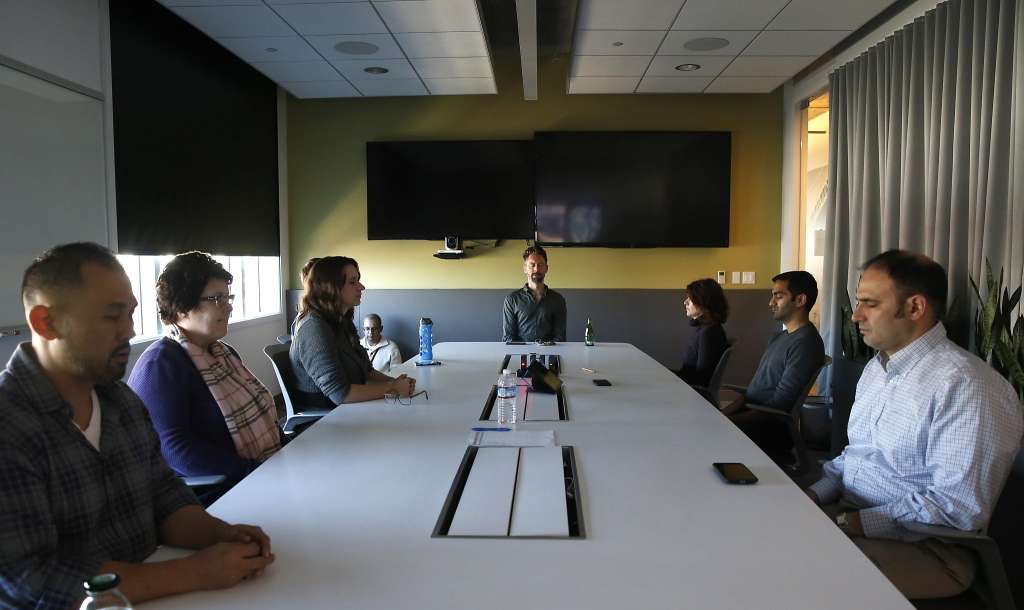
The class ends as all yoga classes do: with a position known as savasana. Corpse pose. A moment meant to be grounding and calm.
But this class is not like most. For one, it takes place in a small conference room on the eighth floor of a San Francisco office building. There are no “oms” or chants. No group breathing. None of that “woo woo” stuff that instructor Kim Sin said can intimidate some. And when class is over, everyone in the room will return to their desks.
“It’s honestly no different than providing a discounted gym membership — it’s basic well-being, and if you can bring it to folks during the day rather than leaving it up to them to go out and find, why wouldn’t you?” said Janetta Wood, vice president of people at Ancestry.com, a Utah company whose San Francisco employees are offered yoga classes, guided meditation and on-site massage. “We’re not talking hours and hours of everyone’s day; we’re talking two hours a week.”
Yoga and meditation classes have become a staple on the sprawling campuses of companies like Google and Facebook, which offer any number of fitness, dance and aerobics classes to their tens of thousands of employees.

Photo: Paul Chinn, The Chronicle
But the practices have been growing in popularity in small offices with more modest accommodations as businesses move away from encouraging employees to go to the gym or a yoga studio on their lunch breaks and, instead, offer in-house options.
The yoga that Sin and other in-office instructors teach has largely been severed from its roots as a spiritual practice. Instead it’s seen — and promoted — as a way to boost productivity, work-life balance and employee wellness. What companies don’t say is that yoga and meditation practices may indirectly benefit their bottom line.
After all, studies have shown, happier workers are more productive.
“It helps (workers) be in the moment, even for just a micro-part of their day, and forces them to step away from whatever project they’re working on and stop obsessively thinking about checking things off their to-do list,” Sin said.
Though there is little reliable research on how many companies offer in-house yoga and meditation classes, the number appears to be on the rise.
Sin said she’s seen demand balloon in recent years, prompting her to hire more teachers and expand her business.
In a book on “mindfulness training” and its popularity in corporate America, journalist David Gelles reported that about one-fourth of the major employers in the U.S. offer some kind of practice in stress reduction and mindfulness — be it yoga, meditation or other means.
“Any work environment can be pretty hectic and can get just stacked up with back-to-back meetings and this gives you a little bit of a breather — literally,” Wood said. “It helps relax both your body and your mind, and I have seen people take that with them through the rest of their day.”
Yoga, a mind-body practice that began as a component of ancient Indian philosophical teachings, has become a mainstay for young, urban professionals. But chic studios and expensive classes can often create a barrier to access — financially and psychologically — that Sin said discourages many people from giving yoga a try.
Many of Sin’s students in the office classes have been first-timers.
“It’s funny, because you can tell they’re a little nervous at the beginning, like ‘I don’t really know what this about but I’m going to try it because someone talked me into it,’ and then they get hooked,” Wood said. “They recognize how valuable it can be for them during the workweek specifically. One of our scientists on our DNA team even started going to yoga classes with his wife outside work.”
Ancestry also offers yoga classes at its Utah headquarters.
Yoga practice is the sixth-most common health practice among American adults, according to a National Health Interview Survey conducted in 2007, the most recent year for which numbers were available.
Research has shown that regular yoga practice can help ease back pain, increase movement, lower blood pressure and reduce stress, in addition to enhancing overall flexibility, strength and fitness.
Meditation, which at Ancestry’s San Francisco office is offered separate from yoga, has been found to decrease stress and improve focus. According to research from the Center for Investigating Healthy Minds at the University of Wisconsin-Madison, it may also boost the immune system and mitigate chronic inflammation and cardiovascular stress.
Sin, a professional in-office instructor, has been teaching conference-room yoga in the Bay Area for seven years.
Though she has worked with a variety of companies across fields, she said, tech companies and their workers seem to be particularly in need of some midday yoga.
“Here, everyone is super stressed and everyone is at different levels of experience, and they’re all in this room together, no matter what department they work in or what their jobs are,” Sin said.
She runs classes throughout the week for San Francisco companies including Zendesk, DroneDeploy and Indeed.
Every office is different, and class sizes vary. At Ancestry, anywhere from a handful to nearly 20 people pack into the conference room turned yoga studio twice a week.
Sin’s service costs companies between $150 and $250 per class.
On a recent Tuesday at Ancestry’s office, office workers fluttered their eyes closed, marking the end of another 50-minute class as muted voices of their colleagues rumbled through the walls.
They were chatting about work, yelling across the crowded room, asking about food orders and lunch plans.
But the other side of the glass, everyone was silent and still.
From: San Francisco Chronicle
Save
Save
